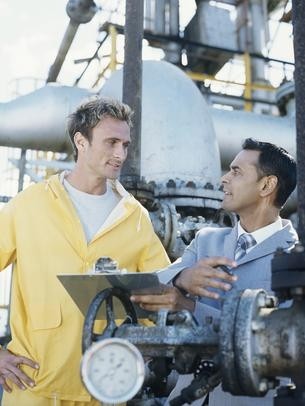Standard Safety Procedures In Manufacturing Engineering

Engineering plays a vital role in the construction of any safety procedure. In the manufacturing industry, safety and engineering become interwoven in the successful completion of a manufactured product. Engineers troubleshoot methods and practices, making them safer for people and property while preserving the financial stability of the business.
Hire an Environmental health and Safety Professional
Staff your manufacturing business is staffed with an environmental health and safety officer. This individual will provide the business with the necessary expertise to decipher the engineering protocols that enact safety procedures, as well as recommend changes as your business grows.
Engineering Controls
• Engineers will create or use engineering controls---existing devices or methods to reduce the risk associated with a process, or instruments used to manufacture a good or service. For example, the fuses in an electrical panel are enclosed in a cabinet with a door that fastens or locks, which protects workers and the cabinet itself. The concept of validation provides another example: One person checks a device or process for adherence to safety, then another person verifies that check. This practice controls, or limits, workers' exposure to hazards---hence the term "engineering control."
Preventive Maintenance
Establish preventive maintenance methods. Keeping machinery and devices in working order prevents mechanical failure and guards against bypass failure. Bypasses are controls put into place to prevent catastrophic failure should an engineering control fail. For example, your business may place a chemical storage tank in a secure enclosure. If by chance a leak compromises the enclosure, preventive maintenance---such as ensuring that supply valves and emergency shut-offs to the tank do not fail---can prevent the bypass failure.
Be Your Own Keeper
Monitor your controls. People and environment will affect engineering controls over time. For example, if rust corrodes a coolant line until critical failure, it ultimately creates a chain reaction that bypasses controls. If the business had monitored the corrosion of the line and replaced it, this type of failure may not have occurred.
Be Vigilant
Audit your procedures. Eventually, almost all procedures require some form of revision. If you have created a new position, you will need to make adjustments in the process. If you replace equipment with a different type or model, you must validate specifications for safety controls.
Hire an Environmental health and Safety Professional
Staff your manufacturing business is staffed with an environmental health and safety officer. This individual will provide the business with the necessary expertise to decipher the engineering protocols that enact safety procedures, as well as recommend changes as your business grows.
Engineering Controls
• Engineers will create or use engineering controls---existing devices or methods to reduce the risk associated with a process, or instruments used to manufacture a good or service. For example, the fuses in an electrical panel are enclosed in a cabinet with a door that fastens or locks, which protects workers and the cabinet itself. The concept of validation provides another example: One person checks a device or process for adherence to safety, then another person verifies that check. This practice controls, or limits, workers' exposure to hazards---hence the term "engineering control."
Preventive Maintenance
Establish preventive maintenance methods. Keeping machinery and devices in working order prevents mechanical failure and guards against bypass failure. Bypasses are controls put into place to prevent catastrophic failure should an engineering control fail. For example, your business may place a chemical storage tank in a secure enclosure. If by chance a leak compromises the enclosure, preventive maintenance---such as ensuring that supply valves and emergency shut-offs to the tank do not fail---can prevent the bypass failure.
Be Your Own Keeper
Monitor your controls. People and environment will affect engineering controls over time. For example, if rust corrodes a coolant line until critical failure, it ultimately creates a chain reaction that bypasses controls. If the business had monitored the corrosion of the line and replaced it, this type of failure may not have occurred.
Be Vigilant
Audit your procedures. Eventually, almost all procedures require some form of revision. If you have created a new position, you will need to make adjustments in the process. If you replace equipment with a different type or model, you must validate specifications for safety controls.
- 9u7660f19cabc391d5844cba12d3b9f516.jpg